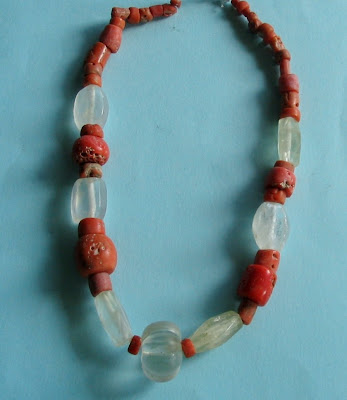I dont know whether this strand of beads with eyes, masks, and also a mouth carved on them should be called eye beads, mask beads or maybe face beads ?
 |
Not Roman, Phoenician, Stratified or Warring States
|
They aren't like the regular eye beads and face beads such as Phoenician eye beads, Warring States eye beads, Stratified eye beads, Roman face beads to name a few of these well known beads which are so covetd by bead collectors
They have an identity of their own
 |
| Very unique beads with eyes or masks carving |
Perhaps they should be called LIANGZHU face beads because they bear strong resemblance to the eye and mask motifs carved on Liangzhu jade congs, plaques, and pendants which are well documented in books and museums. The Liangzhu Culture was a late Neolithic culture which existed from 3300-2250BC and the culture excelled in jade especially the large congs, plaques etc.
 |
| Strong resemblance to Liangzhu eye and mask motifs |
Liangzhu culture eye decorations have been described from haunting to demonic, from divine to bizarre, from god like to bird like, taotie masks to monster design from greedy monsters to benevolent deities . I wonder if my beads qualify for any of these wildly divergent descriptions.
 |
| God-like or bird-like ? |
Although the eye motif which also looks like a mask was common among the important and large jade items of the Liangzhu culture there is a scarcity of research material on beads such as mine so I cannot vouch for their correct vintage. Perhaps they belong to another era and culture altogether. However the likeness to Liangzhu artifacts is uncanny with their haunting mask design, a bar-shaped mouth, raised oval eyes, sunken round pupils, etc
 |
| Uncanny resemblance |
The beads are about 2.3cm for the largest bead and 1.9 for the smallest. Spherical in shape the beads are inordinately heavy and I am not sure whether the stone is jade, serpentine or jasper. Not all have identical carving or the same amount of corrosion and iridescence . Of the 11 beads only a pair have spiral like incisions carved around the oval shaped eyes or masks shown below
 |
| spiral shaped incisions carved around the eyes |
The rest of the beads on the strand have unadorned masked eyes, and a carved outline that ends in a mouth. I will call them Mask Eye Beads !
 |
| Mask eyebeads |
The title of this post, Eyes of Infinite Reverie is a phrase I got from a Chinese source writing on Liangzhu eyes/masks motif which had me wondering. Did the writer mean the eyes are eternally enthralled in thoughts or is it the beholder who becomes eternally bemused by these eyes? Interesting riddle :-))
Here is another profound response from an internet source about these mask eyes
perfect frontal view and symmetry (of these masks) define a fixed visual center which demands the viewer's concentration. The art historian Upensky has contended that such a frontal image embodies an " internal observer" who is "looking out" from an imaginary world. The same logic can be described from the viewers point : in viewing the mask he finds himself in direct confrontation with a "mirror image", which however distorts realty.
Rather
cheem, this observation, but still somewhat apt :-))
I am not saying my beads are the real McCoy yet I am kind of fascinated by their enigmatic expression.
 |
| Like La Belle, these eyes hath thee in thrall ! |




















.jpg)
































